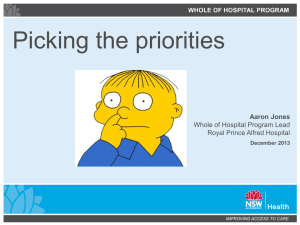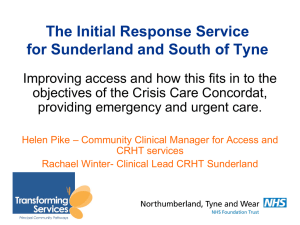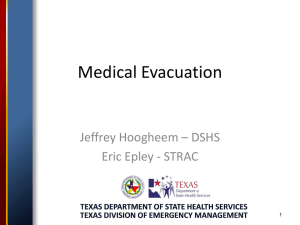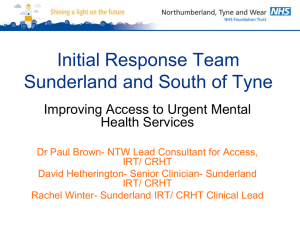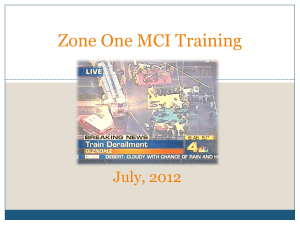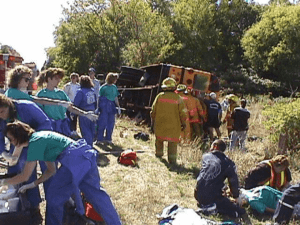OB Triage Process Improvement: A Case Study
advertisement
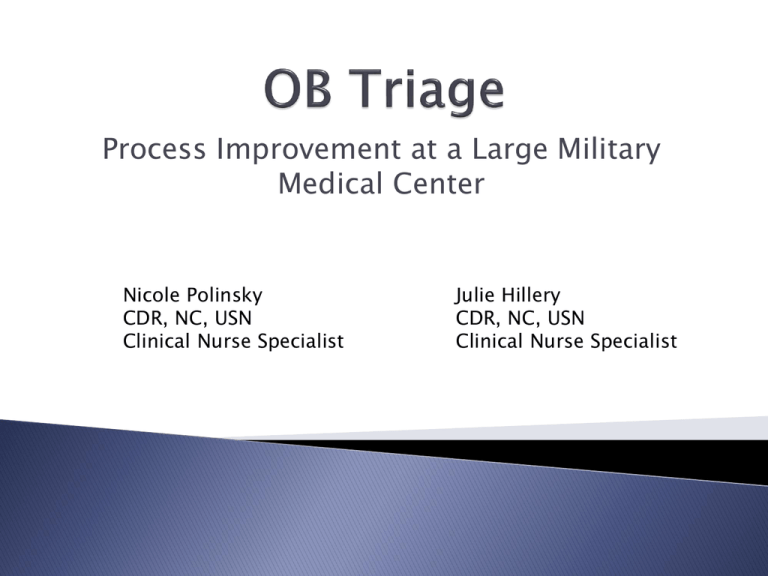
Process Improvement at a Large Military Medical Center Nicole Polinsky CDR, NC, USN Clinical Nurse Specialist Julie Hillery CDR, NC, USN Clinical Nurse Specialist Discuss issues that led to need for process improvement in an OB Triage area. Discuss findings of literature review for obstetric triage practices, standards, and issues. Describe each step of the FOCUS-PDCA cycle as it applies to improvement of OB Triage processes. Identify future implications for clinical nursing and patient safety in OB triage and evaluation. One of three large Navy Medical Centers Annual birth rate = over 4,200 Visits to OB Triage = over 800/month Unit composition: ◦ ◦ ◦ ◦ ◦ 10 LDRs 4 high-risk OB beds (“Special Care”) 3 Operating rooms 5-bed PACU 7-bed Triage area Staffing: ◦ 50 billets for mix of military, civilian, and contract RNs ◦ 15 billets for hospital corpsmen and 2 LPNs ◦ 5 billets for civilian and contract clerks Main Hallway (Not to scale) TR 7 (precip room) Waiting room Check-In TR 6 Vending Machines Doctor & RN desk space TR 5 To Labor & Delivery To OR TR 4 (no central FM) TR 3 TR 2 TR 1 BR Received customer and leadership concerns regarding long wait times in OB Triage. Found that care of patients presenting to OB Evaluation was delayed, which resulted in delay of assessment of fetal and maternal well being Experienced rash of pregnant women being rushed from OB triage and evaluation to operating suite or labor room with virtually no time in OB triage bed. Emergency department was modifying triage system around same time. ◦ Their findings peaked interest among Nursing Directorate leaders regarding standardization between ED triage and OB triage. When a pregnant woman presents for care on labor and delivery, how soon should she be triaged? How soon should she be evaluated? Who can perform triage and evaluation? What are the staffing standards for OB triage areas? What is the current process for maternity patients who present for care? Are the standards of practice for OB triage different than ER triage standards? Patient presents to triage Clerk starts record while patient waits in lobby Clerk notifies RN of patient’s arrival when check-in is complete and chart is ready for use RN triages patients waiting by reviewing the chart and reason for visit Initial assessment by RN is completed when patient is assigned a triage bed Patient in waiting room Reached Out ◦ Email sent to 1920/1964 Listserve (Mother-Baby and NICU nursing community) for input and feedback ◦ Contacted other hospitals and medical centers for policies/procedures/protocols on OB Triage Professional organization standards & guidelines ◦ AWHONN Besuner (2007), Templates for protocols and procedures for maternity services, 2nd Ed. ◦ AAP & ACOG-Perinatal Guidelines, 2007 (6th Ed.) ◦ ACOG-review of compendiums for guidelines/ statements in regard to perinatal evaluation ‣ Literature Review Very few current articles found on obstetric/perinatal triage and evaluation (in Fall 2007). Overall commonalities of articles found: ◦ ◦ ◦ ◦ ◦ ◦ ◦ Common reasons for visits Legal requirements Tiering/classification system Unit-developed protocols Patient flow through triage area Which providers can perform medical screening evaluations (MSEs) Documentation Information mentioned in only one article*: Information not found: ◦ Timeline for triage after presentation ◦ Competency requirements for staff ◦ Staffing standards *Mahlmeister & Van Mullem (2000). The process of triage in perinatal settings: Clinical and legal issues. The Journal of Perinatal and Neonatal Nursing, 13: 13-30. Why review ER Triage? ◦ Obstetric triage falls under the same standards as emergency room triage. Limited search to triage systems ◦ Many articles found (see bibliography) Commonalities: ◦ Triage defined ◦ 5-level v. 3-level acuity scales for triage 5-level preferred; evidence-based system that allows consistency of care, efficient placement of patients, and improved patient flow. Other findings: ◦ Concept of “family waiting or gathering area” Overall issue identified: Care of maternity patients presenting for evaluation was delayed, leading to delay of assessment of fetal and maternal well being Specific issues: ◦ Patients presenting to OB Triage: Were not consistently assessed by an RN within 5 minutes of their arrival. Were initially seen by the unit ward clerk—RN may be unaware of patient’s arrival for significant period of time Had to complete the check-in process before RN was notified of patient’s arrival Waited in the lobby for minutes to several hours before initial assessment was completed Triage was performed and severity level determined through review of record only ◦ Unlike ER Triage, cannot “eyeball” perinatal patients to estimate level of severity because cannot see into the uterus Clinical Nurse Specialist, L&D Division Officer, L&D Staff RNs ◦ Proficient and expert in perinatal nursing ◦ Routinely work in OB Triage ◦ Charge nurses ER Nursing Department Head ◦ Adhoc; for consultation Already discussed: “Triage” was the term used by all disciplines to describe the entire patient visit. ◦ Review of process ◦ Information gathering, literature review. ◦ Triage is actually the action taken during and after the initial (primary) assessment to determine the level of care the patient requires Current staffing: 1 RN for a 7-bed OB Evaluation area with an average of 800 visits/month How process should be: ◦ Patient initially triaged by RN within 5 minutes of presenting to OB Evaluation Area; ward clerk simultaneously completes check-in paperwork ◦ RN categorizes severity of patient’s condition based on chief complaint and assessment findings ◦ RN notifies provider immediately for emergent conditions or upon completion of initial triage for urgent and non urgent conditions ◦ Urgent and Non urgent patients in waiting room are re-assessed every 30-60 minutes (time related to severity category) by an RN “Triage” is term to use for initial/primary assessment “Evaluation” is term to use for the rest of the visit. Staff with 2 RNs at all times: 1 dedicated to initial triage, 1 to provide care for patients in evaluation bed Limited number of RNs available to meet staffing requirement ◦ One (1) RN assigned to 7-bed area with an average of 800 visits/month Physical space inhibited triage process and smooth flow of ongoing care. No unit policy/protocol for OB Triage and Evaluation No severity index used to determine treatment needs No form available for documentation of initial RN triage assessment Poor training and competency validation process in place for RNs “Triage” is term used by all disciplines to describe the area and the entire visit vice initial assessment Lack of guidelines from perinatal professional organizations regarding triage and evaluation of the obstetric patient ◦ OB Triage thought of as “the OB ED” but standard of care not in compliance with ED standards. Patients who present to OB Evaluation will: ◦ Receive an initial triage assessment by an RN within 5 minutes of arrival ◦ Be categorized to level of severity based on chief complaint and assessment findings ◦ Be re-assessed at prescribed times while in the waiting room Standard of care will be evidence-based and in accordance with ED guidelines Remodel physical space to include room for initial triage and doors for ease of patient flow Rename space “OB Evaluation Area” Gain 5 additional RN billets and complete hiring process Develop unit policy/protocol of care that includes definition of severity index for clinical conditions and recommends plan of action Develop form for documentation of RN’s initial triage assessment Improve initial training and competency validation for RNs Train nursing staff on new protocol of care Train medical providers on new protocol of care Develop audit tool for review of records. Main Hallway (Not to scale) TR 7 (precip room) Waiting room Space converted to exam room TR 6 “Front” Check-In Doctor & RN desk space TR 5 To Labor & Delivery “Back” To OR TR 4 (no central FM) TR 3 TR 2 TR 1 BR Area renamed “OB Evaluation (OBE) Area” ◦ “Triage” will be term used to describe initial assessment and determination of care required ◦ Rooms/beds in back will be referred to as “Evaluation” beds OB Evaluation will follow Emergency Department (ED) guidelines regarding standard of care for patients who present ◦ ED standard = patients are seen within 2-5 minutes of arrival Levels of severity for patient conditions defined. Patient condition will be triaged as red, yellow, or green based on reason for visit and assessment findings Red Cardio-respiratory distress Eclampsia Active hemorrhage/ heavy bleeding Urge to push Objects protruding from vagina No fetal movement Diabetic coma/DKA Other lifethreatening conditions to mother or fetus Yellow Contractions every 2 minutes & appears uncomfortable Multipara in active labor Decreased fetal movement Abdominal pain Preterm labor or preterm rupture of membranes Actual or potential Preeclampsia or HELLP syndrome Rule-out ROM Green Nausea/vomiting/ diarrhea Urinary complaints Stable gestational hypertension Wound infection Upper respiratory infection Vaginal discharge/ vaginitis Wound checks Staple removal Injections, lab draws **Yellow conditions are listed in order of priority Red = Emergent Notify Provider Immediately Move patient directly to room: OBE exam, OR, special care, or LDR room Yellow = Urgent (Patient must be seen but will not deteriorate with slight delay in care) Notify provider when RN triage assessment is complete Green = Nonurgent (Patient can wait for several hours with minimal risk of further injury) Notify provider when RN triage assessment is complete Patients sent to the waiting room will be reevaluated as follows until an OBE room is available: ◦ Yellow = every 30 minutes ◦ Green = every hour RN assigned to front is responsible for completing re-evaluations and re-determining condition levels Documentation will be on the new “OB Evaluation Triage Note” form Per the new policy, the following patients may go directly to their assigned room on L&D (no OBE visit required): ◦ Scheduled c-section, induction, cerclage, or version ◦ Presenting for direct admission from clinic ◦ Give birth en route to hospital ◦ In transition or second stage of labor A form was created specifically for documentation of initial assessment by an RN (Title= “NMCP Obstetric Evaluation Triage Note”) ◦ Modeled after the ED initial triage note ◦ Documentation on current ETR and OB TraceVue will continue once the patient is placed in an Evaluation bed Condition Level: Red Date: Name: Arrival Time: Yellow Green Chief complaint or assessment findings significant for: Triage Time: FMP/Sponsor SSN: Age: EDC: EGA: Height: Weight: G: P: T: P: A: L: Barriers to communication: □ No □ Yes: □ Language □ Disability □ Other:___________ Action Taken:_____________ Arrival Via: □ Ambulatory □ Wheelchair □ Gurney □ EMS/Ambulance □ Other Reason for Visit: History of cesarean section? Yes No History of/current placenta previa? Yes No History of/current HSV infection? Yes If yes, for what complications? Allergies/reaction: Current Medications: No Are you seen in the Complicated OB clinic? Yes No Time: Temp: Initial Vital Signs & Obstetric Assessment HR: BP: Pain: rated as __________/10. □ Constant Location:__________________________ RR: □ Intermittent □ Sharp □ Dull □ Pressure Radiation to:_______________________ Cardio-respiratory distress Eclampsia Active hemorrhage/heavy bleeding Urge to push Objects protruding from vagina No fetal movement Diabetic coma/DKA Other life-threatening conditions to mother or fetus Contractions every 2 minutes & appears uncomfortable Multiparas in active labor Decreased fetal movement Abdominal pain Preterm labor or preterm rupture of membranes Pre-eclampsia/ signs/symptoms of Pree/ HELLP syndrome Rule-out rupture of membranes Nausea/vomiting/diarrhea Urinary complaints Stable gestational hypertension Wound infection Upper respiratory infection Vaginal discharge/vaginitis Wound checks Staple removal Injections, lab draws FHT: □ Burning Leaking Fluid? Yes No Unsure Color:___________________________ Time noted: __________ Contractions? Yes No Unsure Frequency: q ____mins or ______ times/hour Regular? Yes No Date/time started: _____________________ Intensity: mild moderate strong Rectal pressure? Yes No Urge to push? Yes No Length of last labor: _____________ Vaginal Bleeding? Yes No Unsure Bright red? Yes No Bloody show? Yes No Feeling baby move like he/she normally does? Yes No Fetal Movements? Feeling 10 or more fetal movements in one hour without difficulty (kick counts)? Yes No Red (Emergent) Notify MO Immediately Yellow (Urgent) Green (Nonurgent) Pt must be seen but will not deteriorate with slight delay in care Notify MO upon completion of RN triage assessment Pt can wait for several hours with minimal risk of further injury Notify MO upon completion of RN triage assessment Additional Notes: Fall risk assessment: □ Level I □ Level II □ Level III □ Side rails up □ Bed locked □ Other:__________________ Domestic violence assessment: Do you feel safe at home?: Yes No History of/current physical abuse? Yes No History of/current sexual abuse: Yes No History of/current verbal abuse? Yes No No Affect: □ Broad □ Flat □ Blunted Mood: □ Depressed □ Labile □ Elated Hallucinations: □ Auditory □ Visual Ideations: □ Harm to self □ Harm to others Behavior: □ Cooperative □ Restless □ Agitated Support System: □ Lives Alone □ Family □ Friends □ Significant Others Time:_________ Dil:__________ Eff:___________ St:_________ Pres:_____________ Vaginal exam: □ Deferred Ongoing Vital Signs & Obstetric Re-assessment Condition Level Time: Temp: HR: RR: BP FHT Pain Ctx’s LOF: VB: -- / + -- / + -- / + -- / + -- / + -- / + Psychosocial: Eye contact?: Yes -- / + -- / + -- / + -- / + -- / + -- / + Provider notified:__________________________________________________ Time:_____________________ Notes: Primary RN Sign Print Signature Initials Signature Initials Per new SOP, RN skill level requirements to work in OB Triage & Evaluation were established as: ◦ RNs who have > 1 year of L&D experience and are at a competent, proficient, or expert level of competency may work in OBE independently ◦ RNs who have > 6 months but <1 year of L&D experience may work in OBE with an RN who meets criteria above ◦ RNs who have < 6 months of L&D experience may work in OBE with an assigned preceptor Other skill level requirements per new SOP: ◦ LPNs and HMs may work in OBE with an RN who has > 1 year L&D experience and is at a competent, proficient, or expert level of competency Training and competency validation ◦ Healthstream training for all staff ◦ Competency checklist created for preceptor to sign ◦ RNs, LPNs, & HMs who work in OBE are required to complete both prior to working independently Modified Triage and OB Evaluation Process Patient presents at OBE front desk Triage RN: Performs initial assessment within 2-5 minutes of patient’s arrival. Categorizes priority of care based on patient complaint & condition. Clerk begins ETR Red (Emergent) Cardio-respiratory distress Eclampsia Active hemorrhage/heavy bleeding Urge to push Objects protruding from vagina No fetal movement Diabetic coma/DKA Other life-threatening conditions to mother or fetus To OBE exam room, operating room, special care room or LDR room Yellow (Urgent) Pt must be seen but will not deteriorate with slight delay in care (can wait for short time) Contractions every 2 minutes & appears uncomfortable Multiparas in active labor Decreased fetal movement Abdominal pain Preterm labor or preterm rupture of membranes Pre-eclampsia/ signs/symptoms of Pre-e/ HELLP syndrome Rule-out rupture of membranes Exam Room Available? Yes To exam room for evaluation. RN reassesses VS, pain, OB condition if > 30 minutes since last assessment. Green (Nonurgent/ambulatory) Pt can wait for several hours with minimal risk of further injury Nausea/vomiting/diarrhea Urinary complaints Stable gestational hypertension Wound infection Upper respiratory infection Vaginal discharge/vaginitis Wound checks Staple removal Injections, lab draws No To waiting area When exam room available Triage RN reassesses VS, FHTs, pain, and OB condition: Every 30 minutes if Cat Yellow Every 60 minutes if Cat Green Medical screening exam performed by provider Priority Level the Same? Interventions and re-evaluation performed as indicated Yes No Disposition determined Start pathway of new category Discharge Home, Full Duty, Light Duty, OB Quarters with instructions and evidence of fetal well being as appropriate to gestational age Admit to Labor & Delivery Notify shift charge RN Give report to admitting RN Escort patient to room Admit to another unit Notify bed management Notify unit’s shift charge RN Call report to admitting RN Escort patient to room Implementation/ “Go Live” date: summer 2008 Teams established to perform data collection & analysis: ◦ Team Leader ◦ Day Shift team (2 RNs and 1 WC) ◦ Night Shift team (2 RNs and 1 WC) Metrics to check: ◦ Arrival time to triage time (is it < 5 minutes?) ◦ Was condition categorized appropriately? ◦ Were ongoing re-assessments performed while patient was in the waiting room? Did her category change (to higher level of urgency)? If so, how long was she in the waiting room? If so, why/how did it change? ◦ Were the following assessments completed? (all boxes checked or filled in): Fall Risk assessment Domestic Violence assessment Psychosocial assessment ◦ Does the RN performing triage have competency documented? ◦ Reason for visit* ◦ Did the RN document procedures performed?* Audit Plan: ◦ 25 records from day shift & 25 records from night shift weekly x 4 weeks ◦ Then 50/day shift and 50/night shift each month Act to hold the gain/continue improvement Act on the information. Adopt the change. Modify or plan accordingly. Perform in an improved manner. Remodel physical space to include room for initial triage and doors for ease of patient flow Rename space “OB Evaluation Area” Gain 5 additional RN billets and complete hiring process Develop unit policy/protocol of care that includes definition of severity index for clinical conditions and recommends plan of action Develop form for documentation of RN’s initial triage assessment Improve initial training and competency validation for RNs Train nursing staff on new protocol of care Train medical providers on new protocol of care Develop audit tool for review of records. Decreased patient wait time for initial assessment from 15 minutes-3 hours to 2-5 minutes. Precipitous delivery rate decreased from 46/month to two in three months. Improved unit lay-out Improved staffing Enhanced patient safety Streamlined documentation Established policy to close triage beds when RN staffing insufficient Turnover of active duty staff Lack of shared vision Deficiency of advanced practice nurses Implement triage competency Revisit audits to ensure meeting standards Expand current Maternal-Infant (1920) core competency to reflect triage practice Clarify roles of triage staff Thank You

